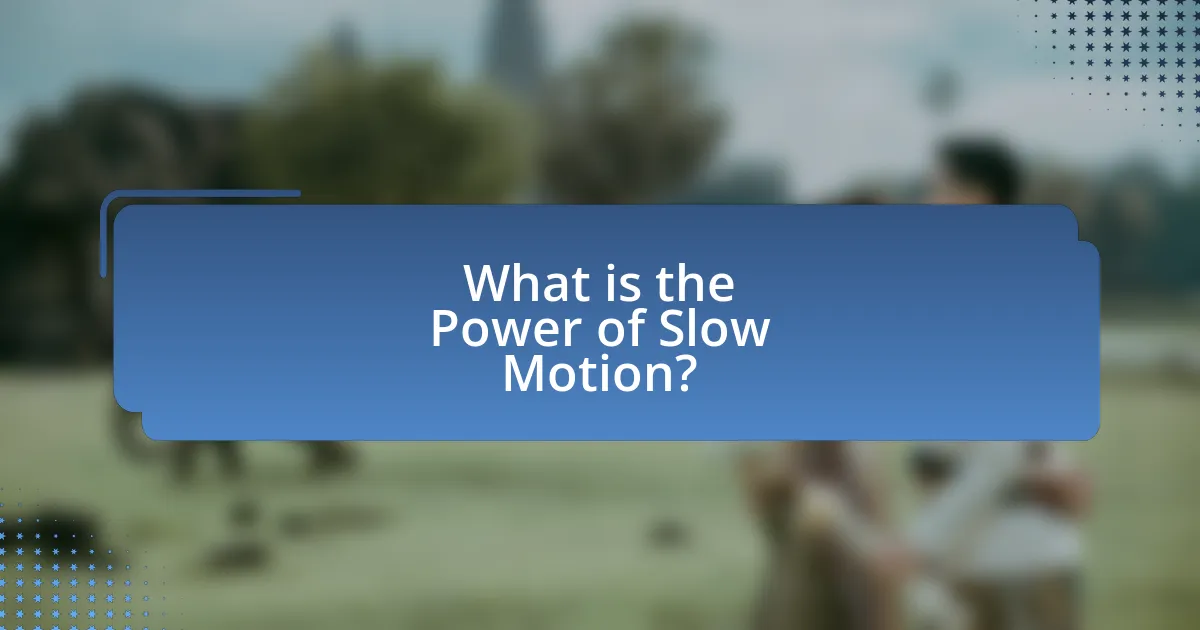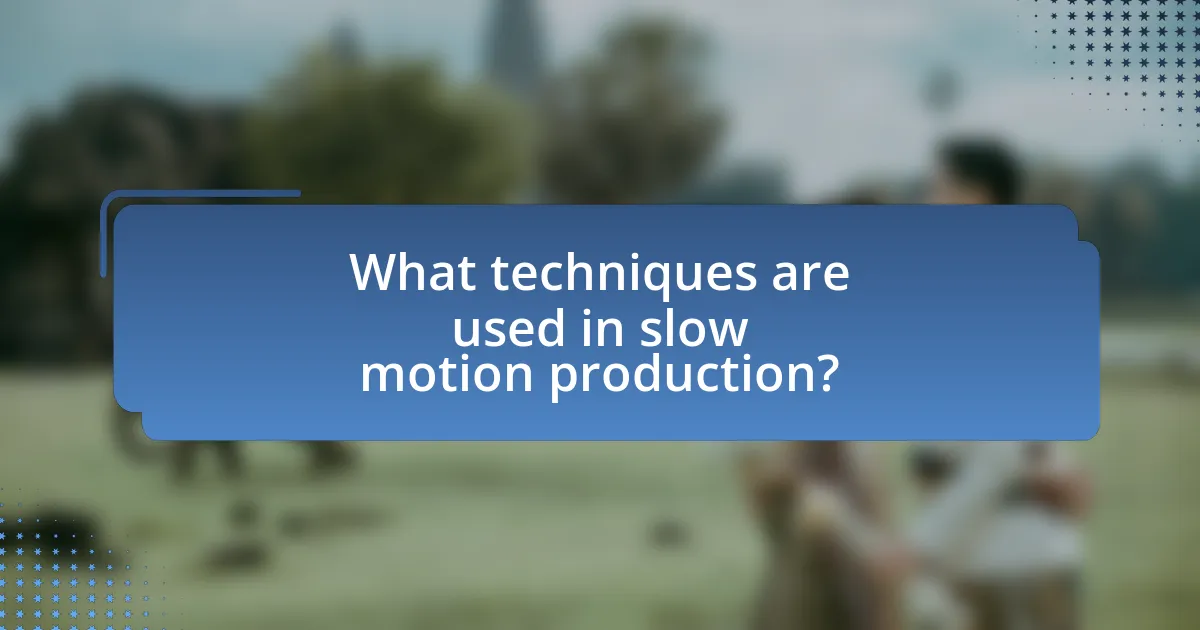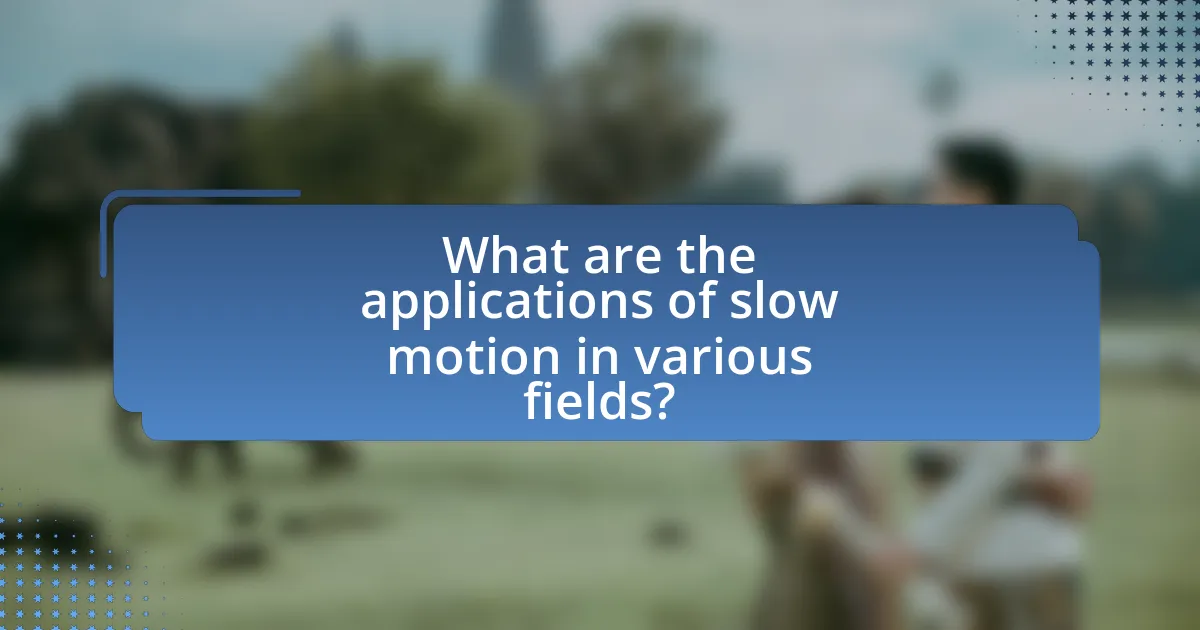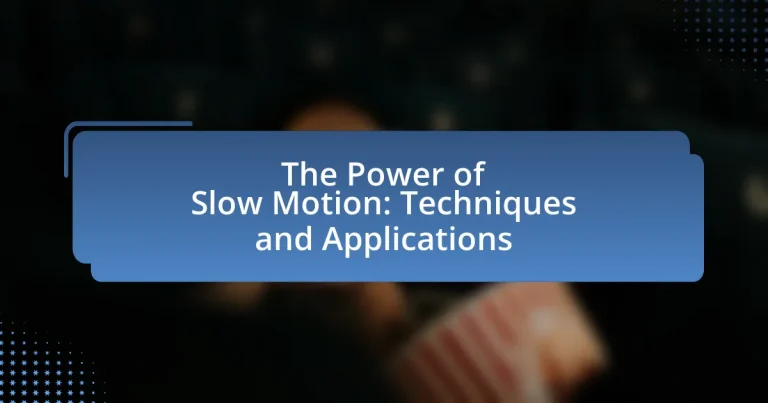The article explores the power of slow motion in visual storytelling, emphasizing its ability to enhance viewer engagement by revealing intricate details and emotions often missed at normal speed. It discusses the technical aspects of capturing slow motion footage, including the importance of high frame rates, camera equipment, and optimal settings. Additionally, the article highlights the significance of slow motion in various fields such as filmmaking, sports analysis, scientific research, and advertising, showcasing its applications and best practices for effective use. Through these insights, the article illustrates how slow motion can amplify emotional impact and improve narrative clarity across different media.

What is the Power of Slow Motion?
The power of slow motion lies in its ability to enhance visual storytelling by allowing viewers to perceive details that are often missed at normal speed. This technique captures rapid movements and actions, revealing intricate nuances and emotions, which can significantly impact the audience’s understanding and engagement. For example, in sports broadcasting, slow motion is used to analyze plays, showcasing the precision and skill of athletes, thereby enriching the viewing experience. Additionally, in filmmaking, slow motion can evoke dramatic tension or highlight pivotal moments, as seen in action sequences where the impact of a scene is amplified.
How does slow motion work in visual media?
Slow motion in visual media works by capturing footage at a higher frame rate than the standard playback rate, allowing for a dramatic deceleration of motion when played back at normal speed. For example, filming at 120 frames per second (fps) and playing it back at 30 fps results in a fourfold slow-motion effect. This technique enhances the visual impact of actions, making them appear more fluid and detailed, which is particularly effective in sports, action sequences, and artistic expressions. The effectiveness of slow motion is supported by its ability to reveal nuances in movement that are imperceptible at regular speed, thereby enriching the viewer’s experience.
What are the technical aspects of capturing slow motion footage?
Capturing slow motion footage involves using high frame rates, typically ranging from 120 frames per second (fps) to over 1000 fps, to record motion in detail. This high frame rate allows for the playback of footage at standard rates, such as 24 or 30 fps, resulting in a slow-motion effect that reveals intricate movements not visible at normal speeds.
Additionally, the choice of camera and lens plays a crucial role; cameras designed for high-speed recording, such as the Phantom Flex or high-end DSLRs with slow-motion capabilities, are essential. Lighting is also critical, as higher frame rates require more light to maintain exposure, often necessitating additional lighting equipment to avoid underexposed footage.
Furthermore, the shutter speed must be adjusted to match the frame rate; a general rule is to set the shutter speed to double the frame rate to achieve natural motion blur. For example, if recording at 240 fps, the shutter speed should be set to 1/480 seconds.
These technical aspects ensure that slow motion footage is captured with clarity and detail, allowing for effective storytelling and visual impact in various applications, from sports analysis to cinematic effects.
How does frame rate influence slow motion effects?
Frame rate significantly influences slow motion effects by determining how many frames are captured per second, which directly affects the smoothness and clarity of the resulting slow motion footage. Higher frame rates, such as 120 frames per second or more, allow for more detailed motion capture, resulting in smoother slow motion playback when the footage is slowed down. For instance, when footage shot at 120 fps is played back at a standard rate of 24 fps, the motion appears five times slower, providing a clear and fluid representation of fast actions. Conversely, lower frame rates, such as 24 fps, can lead to choppy slow motion effects, as there are fewer frames to interpolate, resulting in less detail and potential motion blur. This relationship between frame rate and slow motion is crucial in filmmaking and sports broadcasting, where capturing fast movements with precision is essential for visual storytelling.
Why is slow motion significant in storytelling?
Slow motion is significant in storytelling because it enhances emotional impact and allows audiences to absorb critical moments. By slowing down action, filmmakers can emphasize key events, enabling viewers to experience heightened tension, drama, or beauty. For instance, in action sequences, slow motion can highlight a character’s struggle or triumph, making the moment more memorable. Studies in film theory indicate that this technique can evoke stronger emotional responses, as it gives viewers time to process visual and auditory cues, ultimately deepening their connection to the narrative.
How does slow motion enhance emotional impact in films?
Slow motion enhances emotional impact in films by allowing viewers to fully absorb and connect with pivotal moments. This technique emphasizes facial expressions, subtle gestures, and intricate details that might be overlooked at normal speed, thereby intensifying the audience’s emotional response. For instance, in the film “The Matrix,” the use of slow motion during action sequences highlights the gravity of the characters’ choices, making the stakes feel more significant. Research indicates that slow motion can evoke stronger emotional reactions by creating a sense of heightened awareness and reflection, as demonstrated in studies on viewer engagement and emotional processing in cinematic experiences.
What role does slow motion play in visual aesthetics?
Slow motion enhances visual aesthetics by allowing viewers to perceive details and emotions that are often missed at normal speed. This technique emphasizes movement, texture, and expression, creating a more immersive experience. For instance, in film, slow motion can highlight a character’s emotional response or the intricacies of an action sequence, thereby intensifying the narrative impact. Research indicates that slow motion can evoke stronger emotional reactions from audiences, as it provides a moment for reflection and appreciation of the visual elements presented.

What techniques are used in slow motion production?
Slow motion production primarily utilizes high frame rate (HFR) filming techniques. By capturing footage at significantly higher frame rates, such as 120, 240, or even 1000 frames per second, filmmakers can create smooth and detailed slow-motion effects when played back at standard frame rates like 24 or 30 frames per second. This technique allows for the observation of fast-moving actions in a way that is not perceivable at normal speed, enhancing visual storytelling. For instance, the use of specialized cameras, such as the Phantom Flex, is common in professional slow-motion production, as these cameras are designed to handle high-speed recording effectively.
What equipment is essential for capturing slow motion?
High-speed cameras are essential for capturing slow motion. These cameras can record at frame rates significantly higher than standard cameras, often exceeding 240 frames per second, allowing for smooth playback of fast-moving subjects in slow motion. For instance, professional high-speed cameras like the Phantom Flex4K can record up to 1,000 frames per second at 4K resolution, providing detailed slow-motion footage. Additionally, lenses with fast apertures and stabilization equipment can enhance the quality of slow-motion captures by reducing motion blur and ensuring steady shots.
How do high-speed cameras differ from standard cameras?
High-speed cameras differ from standard cameras primarily in their ability to capture images at significantly higher frame rates, often exceeding 1,000 frames per second, compared to standard cameras that typically operate around 30 frames per second. This capability allows high-speed cameras to record fast-moving subjects in great detail, enabling slow-motion playback that reveals intricate movements and actions that would otherwise be imperceptible. For instance, high-speed cameras are utilized in scientific research and sports analysis to study phenomena such as the impact of a bat on a ball or the motion of a sprinter’s legs, providing insights that standard cameras cannot achieve due to their lower temporal resolution.
What settings are optimal for slow motion filming?
The optimal settings for slow motion filming include a high frame rate, typically between 120 to 240 frames per second (fps), which allows for smooth playback at standard speeds. Additionally, using a shutter speed that is at least double the frame rate, such as 1/250 or 1/500 of a second, helps to reduce motion blur and maintain clarity in fast-moving subjects. Lighting conditions should also be considered, as higher frame rates require more light; therefore, filming in well-lit environments or using additional lighting sources is essential to achieve high-quality slow motion footage.
How can editing software enhance slow motion footage?
Editing software can enhance slow motion footage by allowing for frame interpolation, which creates additional frames to smooth out motion, and by providing tools for color correction and stabilization. Frame interpolation algorithms, such as Optical Flow, analyze existing frames to generate new ones, resulting in smoother playback. Additionally, editing software enables precise adjustments to exposure and color grading, improving the visual quality of slow motion footage. Stabilization tools reduce unwanted camera shake, ensuring that the slow motion effect appears more professional and visually appealing.
What are the best practices for applying slow motion in post-production?
The best practices for applying slow motion in post-production include selecting the right frame rate, ensuring smooth transitions, and maintaining audio quality. Choosing a higher frame rate, such as 120 fps or 240 fps, allows for smoother slow-motion effects when played back at standard rates like 24 fps or 30 fps. Smooth transitions can be achieved by using motion blur effects to avoid choppy visuals, which enhances the overall aesthetic. Additionally, maintaining audio quality is crucial; consider using sound design techniques to complement the visuals, as slowing down audio can distort it. These practices ensure that the slow-motion effect enhances the storytelling without compromising the visual or auditory experience.
How do different software tools compare for slow motion effects?
Different software tools for slow motion effects vary significantly in their capabilities and performance. Adobe Premiere Pro offers advanced frame interpolation, allowing for smooth slow motion by generating intermediate frames, while Final Cut Pro X utilizes optical flow technology for high-quality slow motion. DaVinci Resolve provides robust color grading alongside its slow motion features, making it suitable for professional projects. In contrast, iMovie offers basic slow motion capabilities, which may suffice for casual users but lacks the advanced features of professional software. These differences highlight the importance of selecting the right tool based on the desired quality and complexity of the slow motion effect.

What are the applications of slow motion in various fields?
Slow motion is utilized in various fields such as film production, sports analysis, scientific research, and medical imaging. In film production, slow motion enhances dramatic effect and allows for detailed visual storytelling, as seen in action sequences where movement is accentuated. In sports analysis, coaches and athletes use slow motion to evaluate techniques and improve performance, enabling precise identification of movements and strategies. Scientific research employs slow motion to study fast phenomena, such as chemical reactions or biological processes, allowing for detailed observation that would be impossible at normal speed. In medical imaging, slow motion techniques help visualize physiological processes, such as heartbeats or blood flow, providing critical insights for diagnosis and treatment. These applications demonstrate the versatility and importance of slow motion across multiple disciplines.
How is slow motion utilized in sports broadcasting?
Slow motion is utilized in sports broadcasting to enhance viewer understanding and engagement by allowing detailed analysis of critical moments. This technique enables broadcasters to showcase intricate actions, such as a player’s technique during a shot or the impact of a collision, which would be difficult to appreciate in real-time. For instance, during the 2018 FIFA World Cup, slow-motion replays were frequently used to analyze goals and fouls, providing viewers with a clearer perspective on the events. This application not only improves the viewing experience but also aids commentators in delivering insightful analysis, thereby enriching the overall narrative of the broadcast.
What advantages does slow motion provide in sports analysis?
Slow motion provides significant advantages in sports analysis by allowing detailed examination of athletes’ movements and techniques. This enhanced visibility enables coaches and analysts to identify subtle errors in form, timing, and coordination that may not be apparent at regular speed. For instance, studies have shown that slow motion can reveal the biomechanics of a golfer’s swing or a sprinter’s stride, facilitating targeted feedback and improvement strategies. Additionally, slow motion aids in injury prevention by highlighting potentially harmful movements, thereby contributing to safer training practices.
How does slow motion contribute to viewer engagement in sports?
Slow motion enhances viewer engagement in sports by allowing audiences to closely analyze critical moments, improving their understanding and appreciation of the game. This technique highlights intricate details, such as player movements, strategies, and emotional reactions, which might be missed at regular speed. Research indicates that viewers are more likely to remember and discuss key plays when they are presented in slow motion, as it creates a more immersive experience. For instance, studies show that slow-motion replays can increase viewer retention of information by up to 30%, making the viewing experience more interactive and enjoyable.
What role does slow motion play in scientific research?
Slow motion plays a critical role in scientific research by allowing researchers to analyze fast phenomena in detail. This technique enables the observation of events that occur too quickly for the human eye to perceive, such as the motion of a hummingbird’s wings or the impact of a bullet. By capturing these events at a slower frame rate, scientists can study the mechanics and dynamics involved, leading to insights in fields like biomechanics, physics, and material science. For instance, research published in the journal “Nature” demonstrated how slow-motion video analysis can reveal the intricate movements of animals, enhancing our understanding of their behavior and physiology.
How can slow motion help in studying fast phenomena?
Slow motion helps in studying fast phenomena by allowing researchers to observe and analyze events that occur too quickly for the human eye to perceive in real time. This technique captures high-speed actions, such as a bullet firing or a hummingbird’s wings flapping, enabling detailed examination of motion, timing, and interactions that would otherwise be missed. For instance, high-speed cameras can record at thousands of frames per second, providing insights into the mechanics of rapid processes, which is crucial in fields like physics, biology, and engineering.
What are some examples of scientific applications of slow motion?
Slow motion is utilized in various scientific applications, including biomechanics, fluid dynamics, and high-speed photography. In biomechanics, slow motion allows researchers to analyze human and animal movements in detail, revealing insights into gait, balance, and athletic performance. For instance, studies often employ high-speed cameras to capture the intricate mechanics of running or jumping, enabling a better understanding of injury prevention and performance enhancement. In fluid dynamics, slow motion helps visualize the behavior of fluids, such as the flow of air over a wing or the dynamics of droplets, which is crucial for improving designs in aerodynamics and hydrodynamics. High-speed photography is also used in experiments to capture rapid phenomena, such as explosions or chemical reactions, providing valuable data for analysis and understanding of these processes.
What are the creative uses of slow motion in advertising?
Slow motion in advertising is creatively used to enhance emotional impact, highlight product features, and create a sense of drama. By slowing down action, advertisers can draw attention to specific moments, allowing viewers to fully appreciate the details and emotions involved. For instance, brands like Nike and Coca-Cola have effectively utilized slow motion to emphasize athletic performance and the enjoyment of their products, respectively. Research indicates that slow motion can increase viewer engagement and retention, making advertisements more memorable. This technique not only captivates audiences but also reinforces brand messaging by allowing consumers to connect with the narrative on a deeper level.
How does slow motion influence consumer perception in ads?
Slow motion in advertisements significantly enhances consumer perception by creating a heightened emotional response and increasing the focus on product details. This technique allows viewers to absorb intricate aspects of the product, making it more memorable. Research indicates that slow motion can evoke feelings of nostalgia and awe, which positively influences brand recall and consumer engagement. For instance, a study published in the Journal of Advertising Research found that ads utilizing slow motion led to a 20% increase in viewer retention compared to standard-speed ads. This demonstrates that slow motion effectively captures attention and fosters a deeper connection with the audience, ultimately impacting their purchasing decisions.
What are some successful advertising campaigns that used slow motion?
Some successful advertising campaigns that used slow motion include the Nike “Write the Future” campaign, which showcased athletes in dramatic slow-motion sequences to emphasize their skills and the impact of their actions. Another notable example is the Old Spice “The Man Your Man Could Smell Like” campaign, where slow motion was used to create a humorous and exaggerated portrayal of masculinity. Additionally, the Apple “Shot on iPhone” campaign effectively utilized slow motion to highlight the camera capabilities of the iPhone, showcasing stunning visuals that captivated viewers. These campaigns demonstrate the effectiveness of slow motion in enhancing storytelling and engaging audiences.
What are the best practices for using slow motion effectively?
To use slow motion effectively, filmmakers should focus on capturing high frame rates, ensuring proper lighting, and selecting impactful moments. High frame rates, typically 120 fps or higher, allow for smoother slow-motion playback, enhancing visual clarity. Adequate lighting is crucial, as slow motion can amplify motion blur in poorly lit scenes, diminishing quality. Additionally, choosing moments that convey emotion or action, such as a dramatic fall or a facial expression, maximizes the impact of slow motion, making the scene more engaging for viewers. These practices are supported by industry standards, which emphasize the importance of technical precision and storytelling in visual media.


